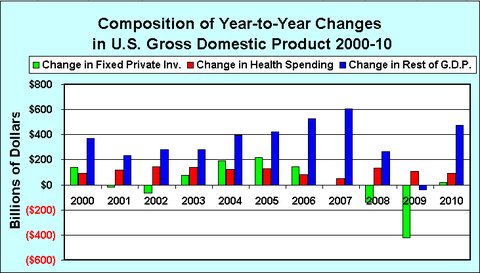Growth in health care spending is expected to slow next year, in part because of a shift in consumer behavior, a report from PricewaterhouseCoopers’s Health Research Institute predicts.
The institute, the research arm of PricewaterhouseCoopers’s health care consulting practice, forecasts overall medical inflation of 6.5 percent in 2014 — down from the institute’s estimate of 7.5 percent for this year. The growth rate — which reflects changes in the actual cost to treat patients, and is influenced mostly by the cost of products and services as well as the number of services used — is often a crucial factor used by insurance companies in setting health insurance premiums.
The estimate is based on medical costs in the large employer market, which covers about 150 million Americans who have insurance through their jobs.
The net growth in spending — after employers tweak their packages of health benefits, such as by raising deductibles for workers — is expected to be about 4.5 percent.
The slower growth is notable, said Ceci Connolly, the institute’s managing director, because in the early 1990s, double-digit medical inflation was the norm. But changes in the health care delivery system — some driven by consumers, who are bearing more of the cost of their medical care — as well as some provisions of the new Affordable Care Act, are helping to slow the rate of increase.
As employers have shifted health care costs to workers by increasing their deductibles — the portion of care they must pay for, before their plan starts paying — consumers are becoming more interested in prices. “When consumers move into high deductible plans, they behave differently,” Ms. Connolly said. “They’re starting to become savvy shoppers.”
They are asking, for instance, whether care can be provided at a retail clinic rather than at a hospital, and requesting lower-cost generic drugs.
When the recession began, consumers started to cut back on medical care or to seek lower-cost options, like retail medical clinics, Ms. Connolly said. But even as the economy has improved, consumers have stuck with the clinics, which typically offer convenient hours as well as lower cost, she said.
According to the report, a visit to a retail clinic costs about $76, compared with about $120 for a visit to a traditional physician’s office.
Consumers are likely to continue seeking more affordable ways to get care, since medical costs aren’t falling, they’re just not going up as fast. Patients can also expect to get more direction from their employers about where to seek medical care, as companies contract directly with “high-value” health systems — those that are seen as delivering quality care at lower cost — to treat their covered employees who need complex care, like heart surgery, the report found.
Have you altered the way you seek medical care because of rising costs? What changes have you made?
Article source: http://bucks.blogs.nytimes.com/2013/06/18/consumers-help-slow-growth-in-health-spending/?partner=rss&emc=rss





